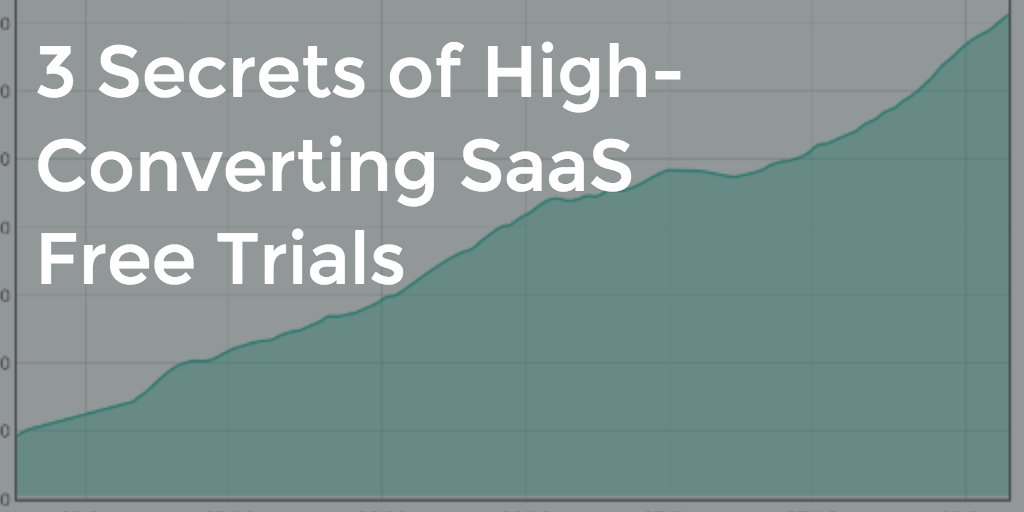 While just about every B2B SaaS company offers a Free Trial – especially those with self-service sales models – in my experience, the percentage of SaaS companies that feel their Free Trial is “successful” is fairly low.
While just about every B2B SaaS company offers a Free Trial – especially those with self-service sales models – in my experience, the percentage of SaaS companies that feel their Free Trial is “successful” is fairly low.
Disappointingly low, actually.
And it absolutely doesn’t have to be that way and in this article I’ll show you how to create high-converting Free Trials!
The Core Inputs for a Successful Free Trial
Now, just to level-set, I’ve talked about the best SaaS Free Trial length, about the best email follow-up sequence, and why the first in-app experience (first-run experience in old-timer parlance) is critical to successfully onboarding your customers.
Of course I’ve also covered how asking for a Credit Card up front is less-than-ideal, how extension requests aren’t a good sign, and how doing nefarious things like forced continuity isn’t cool.
That’s all true still, for sure, and you’ll need to roll all of that into your Free Trial strategy to ensure success.
However, if you really want your Free Trial to knock it out of the park and be that customer-creating machine it should be, I’ve boiled down the…
3 Secrets of High-Converting SaaS Free Trials
These aren’t really secrets as much as they are things that SaaS companies with high-converting Free Trials do that others don’t. If these secrets are hiding… they’re hiding in plain sight.
1. Design For Conversion
Your Free Trial must be designed to quickly get the prospect to a point where becoming a paying customer is the most logical next step. It’s that simple. It’s not necessarily easy, but it’s simple.
You must remember that your customers are approaching your Free Trial as a way to EVALUATE your product to see if it’s right for them… but you must approach the Free Trial to get them to USE your product.
So the point where becoming a paying customer is the most logical next step is either immediately after your customer achieves (or sees that they could actually achieve) their Desired Outcome by actually using the product.
Most SaaS apps do not have a Free Trial that is designed to get a customer to use and then convert to a paying customer… in fact, most don’t even seem to be designed at all.
Letting a prospective customer just poke around and try stuff is pretty much the exact opposite of what I’m talking about here. Any success you have with that “strategy” is in spite of your effort, not because of it. And that isn’t sustainable or scalable. Remember that.
2. Engage Beyond the App
At this stage of their lifecycle with you, your app is not the center of your prospect’s universe, yet.
So you need to take into consideration when designing your Free Trial all of the things that are required to get the prospect to the point where becoming a paying customer is the most logical next step; inside the app and beyond.
You must consider everything that needs to happen in their life to make becoming a paying customer the most logical next step.
What’s going on in their world – outside of the app – that will affect their ability to get to that point and what can you do to design around that or otherwise help them? We want to leave as little to chance as possible.
The more disruption to their existing routine that’s required for a prospect to adopt your product, the more you need to take that into consideration and design your engagement process around that. It’s not all about your product… think beyond the app and really engage your prospect.
Honestly… if you haven’t developed your Ideal Customer Profile, it’s going to be very difficult to understand what’s going on beyond the app that you need to be aware and orchestrate around.
It’s never – ever – just about functional onboarding.
3. Consider All Players
You must take into consideration all of the different participants in the evaluation and buying process… yes, even in a self-service model.
As I mentioned above, it’s critical to remember that the prospect is approaching your Free Trial as if they’re evaluating it… but you must approach it from the “let’s get them to actually use it” standpoint.
So we have to be cognizant of the fact that the person who signs-up for your Free Trial might not make the ultimate decision.
Depending upon who signs up, that could require different paths into the app, different first in-app experience, different path to first value, etc. In fact, you could segment the various aspects of your Free Trial based on entry point (CTA followed from a persona-specific piece of content) or self-selection of role.
Also, the person that signs-up and the one that evaluates a technical/functional fit, may still not be the person that can pay for it so the economic buyer must be introduced (give the ability to invite someone else to the payment flow).
You may find that technical folks might have to get involved, too, where APIs or code snippets are involved (you see this frequently with “mail code to webmaster” for widgets).
And again, if you haven’t defined your Ideal Customer Profile it will be virtually impossible to know who the various players are.
Okay, so those are three high-level ideas that you should use to frame your Free Trial strategy.
If you apply this way of thinking along with all of the other Free Trial concepts I linked to at the top of the article, your Free Trial really can become that a customer-creating machine.
And that’s a lot better than just an under-performing box on a flowchart!



